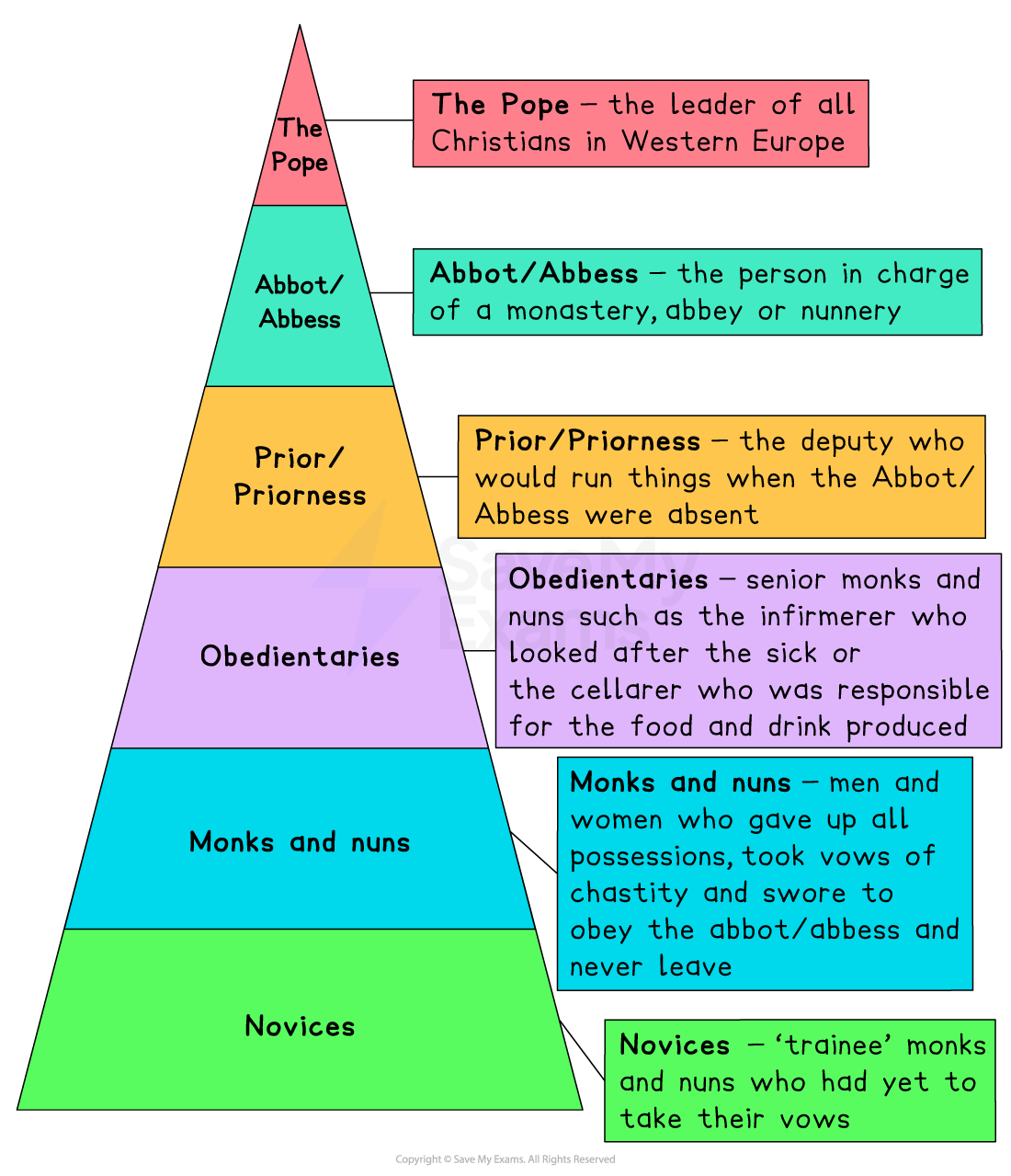Monasteries in Norman England (AQA GCSE History): Revision Note
Exam code: 8145
Summary
Monks and nuns are men and women who devote their lives to God and live in abbeys and nunneries. These institutions are collectively known as monasteries. There had been monasteries in England for centuries but their number greatly increased after the Norman Conquest. Not only did the number of monks, nuns and monasteries increase, but so did the number of religious or monastic orders. Different religious orders followed slightly different rules and routines. Many of the new monastic orders, such as the Cluniacs and the Cistercians, followed much stricter rules than the Anglo-Saxon orders who were viewed as lazy by the Normans. The behaviour and routine of monks were changed as part of Lanfranc’s religious reforms.
Religious orders in Norman England
There were several different religious orders in Norman England and their monks and nuns lived their lives according to the rules of their founder
Benedictine monks followed the rules of St Benedict who had lived in the 6th Century
Different interpretations of St Benedict’s teachings led to the development of ‘splinter’ orders in Norman England
Cluniac monasteries had a strict interpretation of St Benedict’s rules
The first was built at Cluny in France in 910
There were 24 Cluniac monasteries in England by 1077
Cistercians were another order founded according to St Benedict’s principles
The first Cistercian monastery was founded in France in 1098
They believed Cluniacs lived lives that were too comfortable and not in line with St Benedict’s teachings
The first Cistercians settled in England in 1128 but soon spread to very remote places in northern England
Cistercians farmed sheep and became very successful and wealthy
Their success in founding monasteries in wild and remote places became known as the ‘Northern Revival’ of monasteries
Augustinians were inspired by the teachings of St Augustine who lived in the 4th Century
They were distinct from the Benedictine orders in that they were more engaged with the communities around them through their parish work
Colchester Abbey, Holy Trinity Abbey and Waltham Abbey were all notable and successful Norman Augustinian institutions
Reform of Norman monasteries
Much like the rest of the English Church, the monasteries were changed and expanded under the reforms of Lanfranc, the Archbishop of Canterbury
Although there had been monasteries in England since the 5th Century, their numbers were in decline
The Normans also believed that Anglo-Saxon monks and nuns were not living their lives in the correct way
Lanfranc set about increasing the number and raising the behavioural standards of England’s monasteries
Lanfranc’s reforms of the monasteries included:
introducing a new liturgy that was similar to those used in mainland Europe
applying St Benedict’s rules more strictly
introducing new rules about the creation of new saints that required the approval of the pope
bringing in a new hierarchy that made people’s roles and responsibilities much clearer

The Cluniac monasteries were very important and influential in spreading these reforms
They helped improve the discipline and religious standards of all English monasteries
Rebuilding monasteries in Norman England
Image: Key features of a Norman Monastery
The number of monasteries in England increased from around 60 in 1066 to over 250 by 1135
The Normans built monasteries for several reasons:
they provided an important service to society by giving money (alms) to the poor, accommodation for travellers and care for the sick
they became centres of learning, repositories of precious books and, at a time before the printing press, the main manufacturers of books
Norman tenants-in-chief (barons)often built monasteries next to their castles to show they had both God and military might on their side
William I paid for Battle Abbey to be built to commemorate his victory at Hastings
Archbishop Lanfranc was keen to increase monasticism as part of his reforms to the Church in England
Monasteries were attached to 10 of 19 cathedrals in England
As new monastic orders, such as the Cluniacs, became established in England, they began to build their own monasteries, especially in the North
Life of a Norman monk
The exact daily routine of a monk in Norman England depended on their individual responsibilities and the monastic order they belonged to
However, all monks lived simple lives, were celibate and owned no personal property
their lives were completely devoted to praying to God, serving God and studying
Some monks, known as obedientiaries, had particular responsibilities:
the Sacrist arranged services and cared for relics
the Guest-master cared for travellers staying at the monastery
the Cellarer was responsible for the food and drink
the almoner arranged for money (alms) to be given to the poor
the infirmerer looked after the sick
Typical Daily Routine of a Monastery
Midnight | Matins - the first prayers of the day |
3:00 am | Lauds - Morning prayer |
6:00 am | Prime: - Church service |
7:00 am | Days instructions are received from the Abbot/Abbess |
8:00 am | Private prayer |
9:00 am | Terce and Mass services |
12:00 am | Sext service and midday meal |
14:00 pm | Rest |
15:00 pm | None Church service |
16:00 pm | Housekeeping |
18:00 pm | Vespers Church service |
21:00 pm | Compline prayers and then bed |

Unlock more, it's free!
Did this page help you?